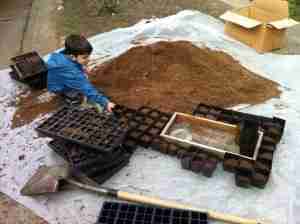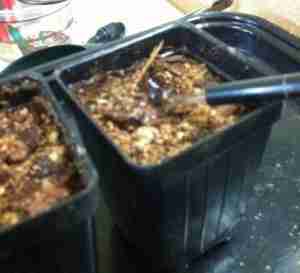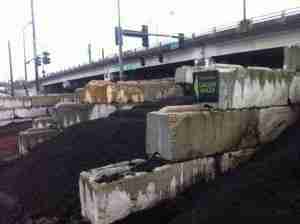 Potting soil is really just a soilless plant medium. You can make your own potting soil if you have a little time and a little knowledge about what is required for a potting medium. Some plants require differing soil contents, drainage, and texture. The only other necessity is the ingredients themselves, and even that can be open to your imagination. You can produce your own specific formula to cater to the particular plants that you are going to use them on.
Potting soil is really just a soilless plant medium. You can make your own potting soil if you have a little time and a little knowledge about what is required for a potting medium. Some plants require differing soil contents, drainage, and texture. The only other necessity is the ingredients themselves, and even that can be open to your imagination. You can produce your own specific formula to cater to the particular plants that you are going to use them on.
Potting mix must have properties that are conducive to maintaining healthy plants. Generally speaking potting mix must hold water well, and drain well. It may sound counterintuitive to retain water and drain, but it isn’t. You want the soil to remain moist but not wet. Moist soil is healthy for most terrestrial plants but too much water and the roots will rot. Maintaining proper conditions is fairly easy to do by adjusting your mix.
 With a few components stored in 5 gallon buckets or zipper style storage bags you can have almost any media ready within minutes. Carnivorous plants and hot peppers require different medium for optimal growth. This can be accomplished readily when you adjust your recipe for the plants you are mixing for. No need to run out to buy mix for a new project.
With a few components stored in 5 gallon buckets or zipper style storage bags you can have almost any media ready within minutes. Carnivorous plants and hot peppers require different medium for optimal growth. This can be accomplished readily when you adjust your recipe for the plants you are mixing for. No need to run out to buy mix for a new project.
Sphagnum peat moss is the most widely recognized component. It is used to primarily retain water, however it drains quite readily unless it has completely dried out, then it becomes hydrophobic. We’ve all seen that plant pot that water just pools on top and won’t soak in. It’s generally not a problem, it’s more of an inconvenience as you need to bottom water or go about it in several installments to get things moving.
Wood stove pellets are a great way to supply the bulk of your potting mix cheaply. You must use wood stove pellets without any additives. They are not hard to find, especially in the fall through early spring. They are cheap and store easily. The major problem with them is that wood creates a drain on nitrogen when it breaks down. This is easily remedied with your fertilizer regiment using a balanced N-P-K to supply needed nitrogen. I’ve potted up and grown on thousands of plants using 80 percent sawdust with no problems at all.
Peat and sawdust are the bulk of the mix and we will talk about accompanying components. Most of the components are there for either retaining water or help in draining. Draining properties come in handy when sprinklers are left on too long, or there’s too much rainfall. The moisture retention components are handy when there’s too little water. Both are equally important and make or break a soilless mix.
Vermiculite and perlite are a very common water retaining component is commercial mixes. However pine bark in fine and medium textures work well. Coconut coir is an excellent material for retaining water and it has a good rewetting property better than sphagnum peat. Luckily these materials help promote proper drainage as well and don’t create drainage problems.
Drainage materials often include coarse grain sand as it allows free drainage. Fine sand should be avoided as it compacts and doesn’t allow water to drain through properly. Coarse sand is available often as builders sand and agricultural sand. Fine gravel as is pumice is also an excellent choice as an additive for drainage. Sand is heavier for shipping but it adds weight which may come in handy for plants grown outside, especially during windy periods. Polystyrene beads, also known as styrofoam, is available as a drainage component but it is prone to blowing all over the growing area as it is very light. For those that ship it might be a good choice to save in shipping costs.
All of these components try to avoid introducing parasites, molds, fungus, and other maladies into your plant propagation project. It is wise to avoid dirt form outside, sand you collect from a riverbank, or compost from a pile outside. An ounce of prevention is worth a pound of cure. Try to use clean materials for your potting and propagation mixes.
 Fertilization is often a grossly overlooked component in potting mixes and propagation media. Many cuttings do not start using nutrients until they begin growing roots, so many do not use fertilizers in rooting media. However some cuttings root rather quickly and nutrient uptake can begin in just a few days. Whenever possible consider using a slow release pelleted fertilizer. Obviously you would not use it for a carnivorous plant mix but some begonias and other similar terrarium plants would greatly benefit in the cutting media.
Fertilization is often a grossly overlooked component in potting mixes and propagation media. Many cuttings do not start using nutrients until they begin growing roots, so many do not use fertilizers in rooting media. However some cuttings root rather quickly and nutrient uptake can begin in just a few days. Whenever possible consider using a slow release pelleted fertilizer. Obviously you would not use it for a carnivorous plant mix but some begonias and other similar terrarium plants would greatly benefit in the cutting media.
More growing media could benefit from adding a slow release fertilizer during potting up. When going to a larger pot (or a pot at all from the propagation trays) use the manufacturers recommendation for the amount of fertilizer to add. If you are using sawdust it would also greatly benefit growing conditions to add a slow release fertilizer for nutrients. Of course a liquid nutrient system could be used during watering sessions or in conjunction with a slow release. The point is to make sure you have plenty of nutrients going to promote growth. There’s quite a bit to proper fertilization in propagation and grow out so it would be wise to research your particular plant and try to customize a nutrient schedule to suit their particular needs.
When mixing using the ‘parts’ method it doesn’t really matter what container you use as long as its the same size. It could be a one cup measuring scoop or a five gallon bucket. As long as each part is added with the same volume as the others it will proportionately be correct.
 Mix the components thoroughly in a container large enough for each batch, or on a tarp on the ground for large batches. Two and three gallon zipper storage bags are good for mixing medium batches for personal collections which makes it easy to mix in the bag and to store. Five gallon buckets are good to store larger batches in. For anything larger than that mixing a batch and potting it up is the best way. Keep it covered in plastic when taking a break or you aren’t using it.
Mix the components thoroughly in a container large enough for each batch, or on a tarp on the ground for large batches. Two and three gallon zipper storage bags are good for mixing medium batches for personal collections which makes it easy to mix in the bag and to store. Five gallon buckets are good to store larger batches in. For anything larger than that mixing a batch and potting it up is the best way. Keep it covered in plastic when taking a break or you aren’t using it.
Potting and propagation mixes shouldn’t be difficult to make to ensure that your propagation project works well. It isn’t an overly complicated matter once you understand the whats and whys of mixes. You’ll be growing more plants than you can use and be trading plants to grow your collection quickly.
(1) Basic Potting Soil Recipe #1
2 parts sawdust
1 part sphagnum peat
2 parts coarse sand
(2) Basic Potting Soil Recipe
3 parts sawdust
2 parts sphagnum peat
2 parts coarse sand
3 parts pinebark
(3) Rooting Mix (cuttings) Recipe
1 parts perlite
1 parts sand
1 parts part peat
(4) Alpine Plants
2 parts coarse sand
1 part fine pine bark
1 part pumice
(5) Orchids and Bromeliads Recipe
6 parts Combination of pine bark and/or porous stone.
1 part of 1/2 -inch charcoal.
(6) Venus Fly Trap Recipe
1 part perlite
1 part peat moss
OR
5 parts peat moss
3 parts coarse sand
2 parts perlite
(7) Emersed Aquatic Recipe
1 part peat
1 part coarse sand
1 part vermiculite
1 part fine pine bark
 Biotope One A Study of Flora and Fauna
Biotope One A Study of Flora and Fauna 


